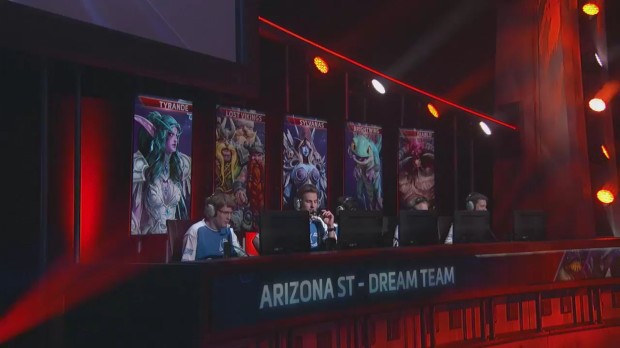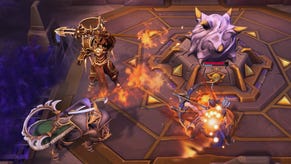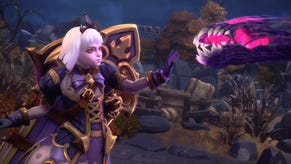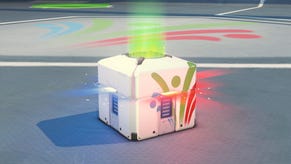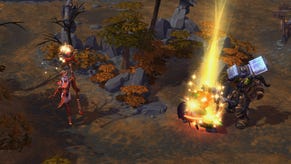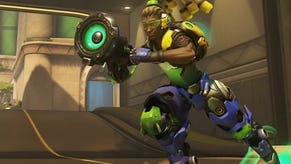What Heroes of the Dorm Means For Blizzard And Esports
We get up-close and personal with Blizzard's eSports strategy
Blizzard's upcoming Heroes of the Storm [official site] is, in my humble opinion, a belter of a game. Such praise is small beer to the Californian mega-developer, however, which with HotS and the upcoming Overwatch intends to reclaim a leading role in the eSports industry it helped to create. HotS is still in beta but the long road began this weekend with Heroes of the Dorm, a college-focused competition that culminated in a grand final broadcast live on ESPN – the latter being not only something of a coup, but also an eSports first. The event laid bare Blizzard's intentions for HotS and, despite some community grumbling, what looks awfully like a new take on how best to present competitive gaming.
There's lots to unpack with Heroes of the Dorm, and the nature of HotS as a competitive spectator sport. Starting with the most obvious, the tournament shows Blizzard adopting a traditional American model that works across basketball, baseball and American football – that is, scholarships. Put aside the fact that it's somewhat unedifying to see young people compete for the privilege of leaving higher education without a crippling debt burden, and this is as American as the stars and stripes. Even if viewers don't necessarily know what eSports is, the scholarship angle gives it a much-needed veneer of familiarity.
The university concept provides other hooks, not the least of which is attracting other students to cheer their team – Berkeley vs Arizona is an instantly-graspable sales pitch. The teams even paralleled this by choosing American sports-style names like Berkeley's Golden Bears.
If outlining such stuff seems like stating the obvious, consider how something like Dota 2's The International was promoted largely through the Compendium. This in-game sticker book helped raise both the prize pool and awareness for the tournament, but is unarguably aimed directly at the hardcore – those people who already play and love the game. The audiences for Dota 2 and LoL are gigantic, but also circumscribed by this – the audience will never grow bigger than the game itself. Riot in fact runs its own collegiate championship, the NACC, but haven't managed to get a broadcast partner like ESPN because no-one outside of LoL players gives a fuck about LoL.
Blizzard clearly aims for HotS to be a first step in making eSports crossover to a more general gaming audience, people who won't necessarily play the game intensely but can still enjoy watching a match or two. We'll come to the design specifics that show this shortly, but it's also important to acknowledge that HotS is part of a process rather than a sole focus: it's surely a Trojan horse for what will be a similar-but-refined approach with Overwatch, a title that potentially has enormous appeal thanks to genre and style.
This thinking is why Heroes of the Dorm ended up on ESPN, which from a community perspective was a bizarre decision – anyone outside the US couldn't watch (you can't buy an ESPN sub in Europe), and even those within it required a cable subscription. It is not that Blizzard wants to alienate existing players but that it wants access to the ESPN audience, experience in a TV environment, and as an incidental bonus the fairydust of legitimacy that such a broadcast brings.
For their part ESPN had a win-win scenario. The final was shown on ESPN2, one of nine channels, allowing the others to focus on usual fare like basketball playoffs, it was a Sunday night so hardly primetime, Blizzard bought up a tonne of ad slots in advance, and as a bonus ESPN gets some positive social media buzz among a demographic it may not usually reach. Much play has been made of the fact that Heroes of the Dorm had a 0.1 rating, which does sound unimpressive, but this represents anywhere between 100,000 and 130,000 viewers – or to put it another way, almost half of Twitch's traffic on the same evening. Not that this is about the direct comparison to Twitch: the whole point is to reach viewers that Twitch can't.
Heroes of the Dorm also brought home that, while HotS' short match length is a great thing for players, it is also a key part of an eSport's appeal. I don't enjoy watching Dota 2 or LoL because the matches take an hour – and such games couldn't be broadcast on ESPN without ad breaks simply overriding chunks of them. HotS fits television better than most of its peers.
The short length of HotS games, which I'd say average out between 15-20 minutes, is not the only part of the game's design that serves both players and the spectator experience. The visual style, as ever with Blizzard, is stylised towards being as readable as possible. You wouldn't necessarily call HotS a beautiful game, because it's aiming for scalability and clarity, but it is a nice-looking game where the immediate action is understandable.
HotS has many other advantages over the competition as a spectator sport. The range of maps provide much more variety, the heroes are more visually striking, and the audio effects are simply incomparable – when a hero dies in HotS, the accompanying SFX is like the very gong of heaven. More importantly, the mechanical design of HotS is so refined that the underlying game shines through: HotS isn't really a Moba, because in comparison to the big two it moves away from stats-juggling, obtuse item systems and alienating terminology. You don't need to study HotS to understand what's going on.
The drive towards clarity goes even further. The last patch to drop for HotS included specific functionality designed for Heroes of the Dorm, such as new spectator options, and when being played competitively the GUI is replaced by more easily-readable spectator icons. The teams and their health bars are also colour-coded and visually simplified. The on-screen furniture during the ESPN broadcast was kept to a minimum, almost too much so, such that there's no minimap on-screen, no experience bars, and one score bar tallying kills, forts, and team members alive. The full-screen minimap that did show up occasionally was one of the night's few disasters, with the icons far too small to make any sense, though doubtless this will be ironed-out by the time of the next tournament.
All of this spectator-focused streamlining is because if you were watching a physical sport, a score bar's all you really need and expect to see on-screen. Obviously with eSports things are a little more complex but one would hope that, as things progress, we start to see more sophistication brought to the design of spectator views – there's no reason Sky Sports should be whizzing possession stats etc around during a football game, while a game full of numbers like HotS has nothing comparable.
The one thing that was missing, and it's impossible to blame anyone for this, is the equivalent of a Madden figure. This is not because the casting and commentary team were bad, quite the opposite – Blizzard regulars Sean 'Day[9]' Plott, Nick 'Tasteless' Plott, and Dan 'Artosis' Stemkoski were joined by Manuel 'Grubby' Shenkhuizen and Tim 'Trikslyr' Frazier, with the latter providing the expert analysis. The problem is that because there's no veteran figure – of course there isn't, the game's not even been released yet – there was a faint whiff of grasping about much of the commentary on big moments: “Just fantastically fantastic teamwork!”
Such minor quibbles shouldn't overshadow the fact that, for a broadcast debut on a big network, Heroes of the Dorm was a professional and slick production. Everything came together, from the position of the commentators, with a sea of clapping sticks and the stage behind, to the colour-coding of the teams on-stage, to the brilliant panels behind each player that showed their character during the pre-match character drafts. There was also an enthusiasm and passion from the players that is often absent from more professional competition, and the spectacle was all the better for it.
Perhaps 'spectacle' is the key word. Heroes of the Dorm felt like an event being broadcast live, a happening, rather than a broadcast event. This distinction may seem overly cute but it's why there was someone in the audience choreographing the clapping sticks (where do they even get those things?), frequent cutaways to other parts of the arena, and why when The Lost Vikings got picked the roof nearly came off the place and you felt the thrill at home.
The final came down to a BO5 between the previously-unbeaten Golden Bears of Berkeley, and Arizona's Dream Team. The Golden Bears were the king of team fights throughout the tournament, often turning bad situations right around with some inspired battling, and boasted among their numbers pro-gamer Suppy. The first match showcased how effective their compositions could be, as they dominated throughout and put down the Dream Team for 1-0 and fears of a whitewash.
Arizona earned their bombastic sobriquet, however, by focusing on map objectives – such a critical part of applying pressure in HotS. A close-fought second match saw them dominate the Golden Bears with this strategy, and the next two games were split by the same tactics – Golden Bears invariably coming out on top in confrontations, with Arizona's map control exerting more and more pressure. I can't comment on how easy HotS is to follow for a non-player, because I play it, but these games were high level and tremendously exciting.
The deciding match came down to an error. The Dream Team, after pushing up to the Golden Bears base, retreated and tried to teleport back to base en masse – but the Golden Bears found them in the bushes and, with several members stranded, pounced mercilessly. They savaged Diablo in seconds and chased the remainder back to base, giving them a numbers advantage and the momentum to quickly push the core for the big GG. Berkeley celebrated a prize that could amount to hundreds of thousands of dollars, while Arizona were left with faint dreams of a fairer society.
Not that some of us watching live were able to see this. One of the interesting decisions made by a combination of Blizzard, ESPN and Twitch was to allow people to watch streamers broadcasting ESPN2 – until the final match. I was one of around 10,000 worldwide watching on Twitch when, in the second match of the final game, all Twitch accounts streaming ESPN2 were suspended.
This was curious timing, particularly as I'd been watching for several hours beforehand. Twitch surely could have shut down the streams earlier, and Blizzard / ESPN must have known this kind of activity was inevitable. Yet they let us get a taste of it, and watch all the ads, before denying the final – and cutting every streamer off at the exact same time. I have no great insight into this behaviour, other than that it is odd – and while I'd normally agree with 'well you shouldn't have been pirating it!' this is made more complex by the fact there was no legitimate way for non-Americans to watch or pay for the event.
Heroes of the Dorm, then, was something of a beta test for an eSport that's still in beta itself. Even at this stage, however, Blizzard's design principles stand tall: the game is easily-readable in action, exciting to watch, and has a rhythm to competitive matches that is utterly absorbing.
Whether it will find that wider audience beyond Twitch is debatable, but the way it is being marketed can only be good for eSports as whole – as it grows competitive gaming must look beyond the audience it already has. HotS is a mould-breaker because it ignores the encrusted design of modern Mobas and returns afresh to the genre's roots. Heroes of the Dorm suggests it could well break free of many other assumptions about what eSports is – and where its future lies.







